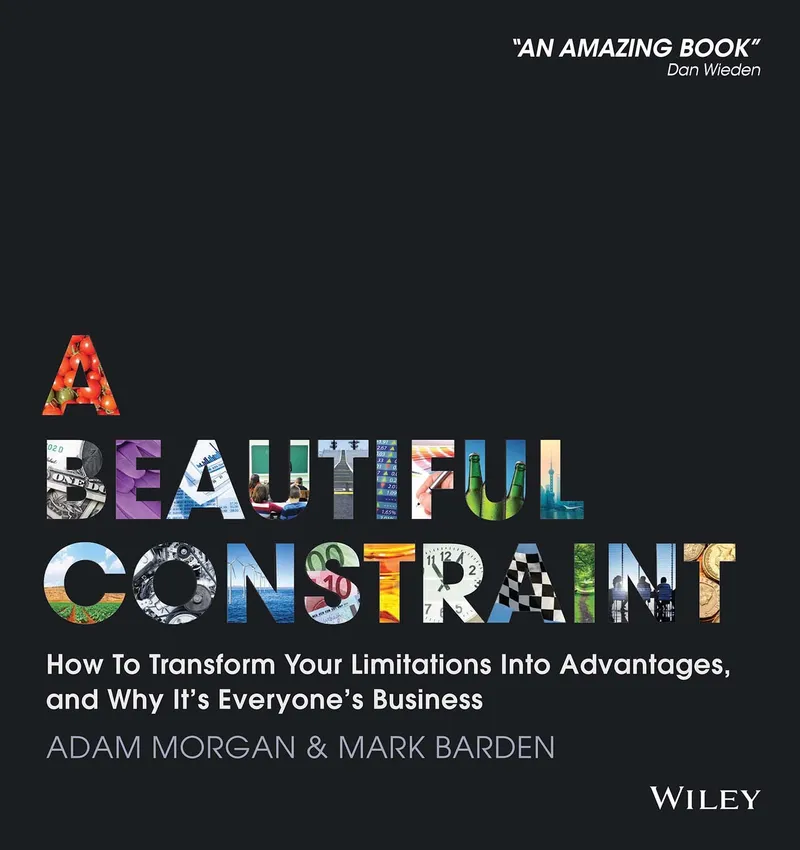How to see your constraints as beautiful – and build a company of sustainable innovation
We live in world where constraints on many resources are increasing, along with a scarcity of time and attention. This book packs in useful insights, tips and frameworks for companies to embrace their constraints and thrive in the long run.

Constraints have often been seen as a drag on creativity and business potential. However, some constraints can also be seen as fertile, beneficial, enabling and even desirable, according to the authors of A Beautiful Constraint: How to Transform your Limitations into Advantages, and Why it's Everyone's Business.
The book is written by Adam Morgan and Mark Barden. Adam, the author of Eating the Big Fish: How Challenger Brands can Compete against Brand Leaders, is the founder of marketing consultancy EatBigFish while Mark runs its west coast business in the US.
The 11 chapters cover 278 pages, along with 15 pages of references and resources. The authors believe that the realities of our century call for a renewed inventiveness to do more with less, and offer a step-wise approach to constraint-driven innovation.
The book will be very useful for entrepreneurs, artists, designers and innovators in organisations of all types. See also my reviews of the related books Frugal Innovation, The Startup Way, Cross-Industry Innovation, The Sharing Economy, and Scaling Up.
Change the mindset
Constraints can be tackled by increase in ambition to overcome them. There are three kinds of responses to constraints: victim (reduction of ambition), neutralising (workarounds), and transformer (responsive: think/act different; proactive: impose new constraints).
Transformative approaches led to the rise of Netafin (drip irrigation company), the Nike ‘Just Do It’ campaign (the brief was for an ad that looked nothing like an ad), and Jerry Seinfeld (comedy without swearwords).
Break path dependence
List out all assumptions, beliefs and even the language of current dominant paths. It is these locked-in biases and priorities that make us blind to new ways of doing things.
Breaking such blocks has led to frameworks such as reverse innovation, which challenge the bias that innovation flows only from mature to emerging economies. Another example is the use of clickers in remedial classrooms in California so that students can immediately signal where they are having problems in comprehending a lesson.
Aircraft carriers were invented by reconceptualising take-off and storage of planes, via catapults, elevators and folding wings. Unilever’s Sustainable Living Plan set a target of doubling size while halving environmental footprint. Air New Zealand and Qantas make their flight safety videos engaging instead of boring.

Ask breakthrough questions
Propelling or breakthrough questions help transform constraints and find innovative pathways. Constraints are usually of finance, resources, time, talent, effort, method and foundation. They can be overcome with ambitions of better quality, experience, impact, growth and superiority.
Questions to provoke new thinking can be paradoxical, irritating, perplexing, unreasonable, and even confounding in the beginning, according to the authors. But such “impossible” questions led to innovative projects at a number of companies.
They include Rent the Runway (high fashion on rent), AirBnB (spare homerooms for travellers), Google (driverless cars), Tesla (electric but fast cars), Audi (race car that was not faster but required fewer pit stops), IKEA (five-euro table), South African Breweries (using wheat farming practices to improve barley yield), Warby Parker (new business model for the eyewear industry), and Zappos (“happiness in a box” for satisfied shoe customers).
“If we don’t ask propelling questions of ourselves, someone is going to ask them of us, and by that time we will be behind the curve,” the authors warn.
Ask "Can-If" questions to guide conversation to solutions
A cascade of “We can if” questions build momentum to find solutions that overcome constraints; they overcome the mental blocks of “We can’t because” attitudes. They include approaches of substitution, addition, removal, funding, mixing and rationalising components.
This approach led to innovative approaches in Taiwan (universal elementary education), Junos Finanzas (financial literacy tool using basic SMS), London sports stadiums (playing music to make people linger after a game and not crowd the exits), DuoLingo (free online translation by making students do it as homework), PHD media planner (internal crowdsourcing platform for brainstorming), and the foodtruck movement.

Create abundance via external resources
Tap the resources of your stakeholders, partners, other companies and even competitors. Create a “mutually beneficial hustle” of trade or co-creation.
This has been used by “improv” theatre (tap audience participation), ColaLife (nutrition NGO in Africa that uses Coca-Cola’s distribution network), IKEA (using feather waste in China for pillows), Airbus (Smarter Skies initiative for airline collaboration to reduce carbon emissions), and Virgin (in-flight marketing for Victoria’s Secret and Google Chromebook).
Activate strong emotions to fuel tenacity
Emotional engagement builds on the earlier mindset approaches and processes. Contrasts and dissonance can create healthy tension and build a propelling emotional narrative. Love, desire, pride, and excitement are great for motivation and inspiration – but it’s also possible to constructively tap fear, rage, greed and even hate.
“Negative emotions can help drive persistence commitment and focus. Positive emotions help stimulate cognitive flexibility and the ability to see new kinds of connection. Imagine what we can do with both,” the authors explain, drawing on the emotion maps of Robert Plutchik.
Such a mix of emotions helped Ravi Naidoo (creator of South Africa’s Design Indaba conference), BrewDog (craft beer with an angry disdain for industrial beer), and Stanford d.School (Design for Extreme Affordability).

Learn from those who had almost nothing
We can learn a lot about mindsets and capabilities from people who succeeded despite having limited resources (‘Fertile Zero’). The authors observe that large firms tend to lose their ability to operate under tight constraints, unlike early-stage startups.
Such innovators offer useful lessons in how to use drama and surprise (Warby Parker’s use of jokes in their annual report), project themselves as interesting (Betabrand’s crowdsourced customer photos for corduroys), and form alliances (CitizenM budget hotel’s lobbies as furniture showrooms).
Create a constraint-driven culture
There are many large companies that routinely embrace constraints, prepare themselves to live in a world of ambiguity, and promote this culture through storytelling, internal knowledge newsletters, and business model support. They couple vision and capacity with realistic work plans and targets.
Leaders of such organisations steer their teams towards constraint-based targets, set high levels of ambition, and know how to manage transformation. For example, IKEA was born of constraints in rural Sweden, and has embraced them ever since.
Nike initially was under pressure by NGOs to examine its “sweatshop” practices, but now uses constraints as a stimulant for innovation. It turns these responses into competitive advantage (eg a sustainability index for all its products).
Unilever’s Sustainable Living Plan has led it to support environmentally-friendly practices in the palm oil and fishery industries. It transformed its CSR group into Sustainable Business and Innovation.
In the long run, our world will be a blend of scarcities and abundance in the physical and digital worlds. “Constraints, and our ability to transform them, sit right at the intersection between scarcity and abundance,” the authors explain.
Developing this capability is not just the job of engineers, designers and managers – it is everyone’s business now, the authors sign off.








